Characterizing Changes in Grain Growth, Mechanical Properties, and Transformation Properties in Differently Sintered and Annealed Binder-Jet 3D Printed 14M Ni–Mn–Ga Magnetic Shape Memory Alloys
Abstract
1. Introduction
2. Materials and Methods
3. Results and Discussion
4. Conclusions
Supplementary Materials
Author Contributions
Funding
Data Availability Statement
Acknowledgments
Conflicts of Interest
References
- Ullakko, K.; Huang, J.K.; Kantner, C.; O’Handley, R.C.; Kokorin, V.V. Large magnetic-field-induced strains in Ni2MnGa single crystals. Appl. Phys. Lett. 1996, 69, 1966–1968. [Google Scholar] [CrossRef]
- Ullakko, K. Magnetically controlled shape memory alloys: A new class of actuator materials. J. Mater. Eng. Perform. 1996, 5, 405–409. [Google Scholar] [CrossRef]
- Henry, C.P.; Bono, D.; Feuchtwanger, J.; Allen, S.M.; O’Handley, R.C. AC field-induced actuation of single crystal Ni–Mn–Ga. J. Appl. Phys. 2002, 91, 7810. [Google Scholar] [CrossRef]
- Toman, J.; Müllner, P.; Chmielus, M. Properties of as-deposited and heat-treated Ni-Mn-Ga magnetic shape memory alloy processed by directed energy deposition. J. Alloys Compd. 2018, 752, 455–463. [Google Scholar] [CrossRef]
- Müllner, P.; Chernenko, V.A.; Kostorz, G. Large cyclic magnetic-field-induced deformation in orthorhombic (14M) Ni–Mn–Ga martensite. J. Appl. Phys. 2004, 95, 1531–1536. [Google Scholar] [CrossRef]
- Tao, T.; Liang, Y.C. Bio-inspired Actuating System for Swimming Using Shape Memory Alloy Composites. Int. J. Autom. Comput. 2006, 3, 366–373. [Google Scholar] [CrossRef]
- Smith, A.R.; Tellinen, J.; Ullakko, K. Rapid actuation and response of Ni–Mn–Ga to magnetic-field-induced stress. Acta Mater. 2014, 80, 373–379. [Google Scholar] [CrossRef]
- Suorsa, I.; Pagounis, E.; Ullakko, K. Magnetic shape memory actuator performance. J. Magn. Magn. Mater. 2004, 272–276, 2029–2030. [Google Scholar] [CrossRef]
- Musiienko, D.; Saren, A.; Straka, L.; Vronka, M.; Kopeček, J.; Heczko, O.; Sozinov, A.; Ullakko, K. Ultrafast actuation of Ni-Mn-Ga micropillars by pulsed magnetic field. Scr. Mater. 2019, 162, 482–485. [Google Scholar] [CrossRef]
- Witherspoon, C.; Zheng, P.; Chmielus, M.; Dunand, D.C.; Müllner, P. Effect of porosity on the magneto-mechanical behavior of polycrystalline magnetic shape-memory Ni–Mn–Ga foams. Acta Mater. 2015, 92, 64–71. [Google Scholar] [CrossRef]
- Sozinov, A.; Likhachev, A.A.; Lanska, N.; Ullakko, K. Giant magnetic-field-induced strain in NiMnGa seven-layered martensitic phase. Appl. Phys. Lett. 2002, 80, 1746. [Google Scholar] [CrossRef]
- Roy, S.; Blackburn, E.; Valvidares, S.M.; Fitzsimmons, M.R.; Vogel, S.C.; Khan, M.; Dubenko, I.; Stadler, S.; Ali, N.; Sinha, S.K.; et al. Delocalization and hybridization enhance the magnetocaloric effect in Cu-doped Ni2MnGa. Phys. Rev. B 2009, 79, 235127. [Google Scholar] [CrossRef]
- Wilson, S.A.; Jourdain, R.P.J.; Zhang, Q.; Dorey, R.A.; Bowen, C.R.; Willander, M.; Wahab, Q.U.; Willander, M.; Al-hilli, S.M.; Nur, O.; et al. New materials for micro-scale sensors and actuators: An engineering review. Mater. Sci. Eng. R Rep. 2007, 56, 1–129. [Google Scholar] [CrossRef]
- Lázpita, P.; Rojo, G.; Gutiérrez, J.; Barandiaran, J.M.; O’Handley, R.C. Correlation between magnetization and deformation in a NiMnGa shape memory alloy polycrystalline ribbon. Sens. Lett. 2007, 5, 65–68. [Google Scholar] [CrossRef]
- Caputo, M.; Solomon, C.V.; Nguyen, P.-K.; Berkowitz, A.E. Electron Microscopy Investigation of Binder Saturation and Microstructural Defects in Functional Parts Made by Additive Manufacturing. Microsc. Microanal. 2016, 22, 1770–1771. [Google Scholar] [CrossRef]
- Ullakko, K.; Chmielus, M.; Müllner, P. Stabilizing a fine twin structure in Ni-Mn-Ga samples by coatings and ion implantation. Scr. Mater. 2015, 94, 40–43. [Google Scholar] [CrossRef][Green Version]
- Chmielus, M.; Witherspoon, C.; Ullakko, K.; Müllner, P.; Schneider, R. Effects of Surface Damage on Twinning Stress and the Stability of Twin Microstructures of Magnetic Shape Memory Alloys. Acta Mater. 2011, 59, 2948–2956. [Google Scholar] [CrossRef]
- Chmielus, M.; Glavatskyy, I.; Hoffmann, J.U.; Chernenko, V.A.; Schneider, R.; Müllner, P. Influence of Constraints and Twinning Stress on Magnetic Field-Induced Strain of Magnetic Shape-Memory Alloys. Scr. Mater. 2011, 64, 888–891. [Google Scholar] [CrossRef]
- Caputo, M.P.; Solomon, C.V. A Facile Method for Producing Porous Parts with Complex Geometries from Ferromagnetic Ni-Mn-Ga Shape Memory Alloys. Mater. Lett. 2017, 200, 87–89. [Google Scholar] [CrossRef]
- Boonyongmaneerat, Y.; Chmielus, M.; Dunand, D.C.; Müllner, P. Increasing Magnetoplasticity in Polycrystalline Ni-Mn-Ga by Reducing Internal Constraints through Porosity. Phys. Rev. Lett. 2007, 99, 247201. [Google Scholar] [CrossRef]
- Chmielus, M.; Zhang, X.X.; Witherspoon, C.; Dunand, D.C.; Müllner, P. Giant Magnetic-Field-Induced Strains in Polycrystalline Ni–Mn–Ga Foams. Nat. Mater. 2009, 8, 863–866. [Google Scholar] [CrossRef] [PubMed]
- Lu, K.; Reynolds, W.T. 3DP Process for Fine Mesh Structure Printing. Powder Technol. 2008, 187, 11–18. [Google Scholar] [CrossRef]
- Taylor, S.L.; Shah, R.N.; Dunand, D.C. Ni-Mn-Ga Micro-Trusses via Sintering of 3D-Printed Inks Containing Elemental Powders. Acta Mater. 2018, 143, 20–29. [Google Scholar] [CrossRef]
- Mostafaei, A.; Rodriguez De Vecchis, P.; Stevens, E.L.; Chmielus, M. Sintering Regimes and Resulting Microstructure and Properties of Binder Jet 3D Printed Ni-Mn-Ga Magnetic Shape Memory Alloys. Acta Mater. 2018, 154, 355–364. [Google Scholar] [CrossRef]
- Mostafaei, A.; Kimes, K.A.; Stevens, E.L.; Toman, J.; Krimer, Y.L.; Ullakko, K.; Chmielus, M. Microstructural Evolution and Magnetic Properties of Binder Jet Additive Manufactured Ni-Mn-Ga Magnetic Shape Memory Alloy Foam. Acta Mater. 2017, 131, 482–490. [Google Scholar] [CrossRef]
- Caputo, M.P.; Berkowitz, A.E.; Armstrong, A.; Müllner, P.; Solomon, C.V. 4D Printing of Net Shape Parts Made from Ni-Mn-Ga Magnetic Shape-Memory Alloys. Addit. Manuf. 2018, 21, 579–588. [Google Scholar] [CrossRef]
- Mostafaei, A.; Elliott, A.M.; Barnes, J.E.; Li, F.; Tan, W.; Cramer, C.L.; Nandwana, P.; Chmielus, M. Binder jet 3D printing—Process parameters, materials, properties, modeling, and challenges. Prog. Mater. Sci. 2021, 119, 100707. [Google Scholar] [CrossRef]
- Wimpory, R.C.; Mikula, P.; Šaroun, J.; Poeste, T.; Li, J.; Hofmann, M.; Schneider, R. Efficiency Boost of the Materials Science Diffractometer E3 at BENSC: One Order of Magnitude Due to a Horizontally and Vertically Focusing Monochromator. Neutron News 2008, 19, 16–19. [Google Scholar] [CrossRef]
- Chmielus, M.; Witherspoon, C.; Wimpory, R.C.; Paulke, A.; Hilger, A.; Zhang, X.; Dunand, D.C.; Müllner, P. Magnetic-Field-Induced Recovery Strain in Polycrystalline Ni–Mn–Ga Foam. J. Appl. Phys. 2010, 108, 123526. [Google Scholar] [CrossRef]
- Rueden, C.T.; Schindelin, J.; Hiner, M.C.; DeZonia, B.E.; Walter, A.E.; Arena, E.T.; Eliceiri, K.W. ImageJ2: ImageJ for the next Generation of Scientific Image Data. BMC Bioinform. 2017, 18, 529. [Google Scholar] [CrossRef]
- Schindelin, J.; Arganda-Carreras, I.; Frise, E.; Kaynig, V.; Longair, M.; Pietzsch, T.; Preibisch, S.; Rueden, C.; Saalfeld, S.; Schmid, B.; et al. Fiji: An Open-Source Platform for Biological-Image Analysis. Nat. Methods 2012, 9, 676–682. [Google Scholar] [CrossRef] [PubMed]
- Mostafaei, A.; Rodriguez De Vecchis, P.; Nettleship, I.; Chmielus, M. Effect of Powder Size Distribution on Densification and Microstructural Evolution of Binder-Jet 3D-Printed Alloy 625. Mater. Des. 2019, 162, 375–383. [Google Scholar] [CrossRef]
- McIntyre, G.J. Area Detectors in Single-Crystal Neutron Diffraction. J. Phys. D Appl. Phys. 2015, 48, 504002. [Google Scholar] [CrossRef]
- Overholser, R.W.; Wuttig, M.; Neumann, D.A. Chemical Ordering in Ni-Mn-Ga Heusler Alloys. Scr. Mater. 1999, 40, 1095–1102. [Google Scholar] [CrossRef]
- Gibson, L.J.; Ashby, M.F. Cellular Solids: Structure and Properties, 2nd ed.; Cambridge University Press: Cambridge, UK, 1999. [Google Scholar]
- Chicot, D.; N’Jock, M.Y.; Roudet, F.; Decoopman, X.; Staia, M.H.; Puchi-Cabrera, E.S. Some Improvements for Determining the Hardness of Homogeneous Materials from the Work-of-Indentation. Int. J. Mech. Sci. 2016, 105, 279–290. [Google Scholar] [CrossRef]
- Chen, Z.; Wang, X.; Bhakhri, V.; Giuliani, F.; Atkinson, A. Nanoindentation of Porous Bulk and Thin Films of La0.6Sr0.4Co0.2Fe0.8O3−δ. Acta Mater. 2013, 61, 5720–5734. [Google Scholar] [CrossRef]
- Kohl, M.; Agarwal, A.; Chernenko, V.A.; Ohtsuka, M.; Seemann, K. Shape Memory Effect and Magnetostriction in Polycrystalline Ni–Mn–Ga Thin Film Microactuators. Mater. Sci. Eng. A 2006, 438–440, 940–943. [Google Scholar] [CrossRef]
- Zorzi, J.E.; Perottoni, C.A. Estimating Young’s Modulus and Poisson’s Ratio by Instrumented Indentation Test. Mater. Sci. Eng. A 2013, 574, 25–30. [Google Scholar] [CrossRef]
- Ozdemir Kart, S.; Cagın, T. Elastic Properties of Ni2MnGa from First-Principles Calculations. J. Alloys Compd. 2010, 508, 177–183. [Google Scholar] [CrossRef]
- Kustov, S.; Saren, A.; Sozinov, A.; Kaminskii, V.; Ullakko, K. Ultrahigh Damping and Young’s Modulus Softening Due to a/b Twins in 10M Ni-Mn-Ga Martensite. Scr. Mater. 2020, 178, 483–488. [Google Scholar] [CrossRef]
- Chmielus, M.; Rolfs, K.; Wimpory, R.; Reimers, W.; Müllner, P.; Schneider, R. Effects of Surface Roughness and Training on the Twinning Stress of Ni–Mn–Ga Single Crystals. Acta Mater. 2010, 58, 3952–3962. [Google Scholar] [CrossRef]
- Jayaraman, A.; Kiran, M.S.R.N.; Ramamurty, U. Mechanical Anisotropy in Austenitic NiMnGa Alloy: Nanoindentation Studies. Crystals 2017, 7, 254. [Google Scholar] [CrossRef]
- Kramer, D.; Huang, H.; Kriese, M.; Robach, J.; Nelson, J.; Wright, A.; Bahr, D.; Gerberich, W.W. Yield Strength Predictions from the Plastic Zone around Nanocontacts. Acta Mater. 1998, 47, 333–343. [Google Scholar] [CrossRef]
- Li, T.L.; Gao, Y.F.; Bei, H.; George, E.P. Indentation Schmid Factor and Orientation Dependence of Nanoindentation Pop-in Behavior of NiAl Single Crystals. J. Mech. Phys. Solids 2011, 59, 1147–1162. [Google Scholar] [CrossRef]
- Aaltio, I.; Liu, X.W.; Valden, M.; Lahtonen, K.; Söderberg, O.; Ge, Y.; Hannula, S.-P. Nanoscale Surface Properties of a Ni–Mn–Ga 10M Magnetic Shape Memory Alloy. J. Alloys Compd. 2013, 577, S367–S371. [Google Scholar] [CrossRef]
- Davis, P.H.; Efaw, C.M.; Patten, L.K.; Hollar, C.; Watson, C.S.; Knowlton, W.B.; Müllner, P. Localized Deformation in Ni-Mn-Ga Single Crystals. J. Appl. Phys. 2018, 123, 215102. [Google Scholar] [CrossRef]
- Tian, X.H.; Sui, J.H.; Zhang, X.; Zheng, X.H.; Cai, W. Grain Size Effect on Martensitic Transformation, Mechanical and Magnetic Properties of Ni–Mn–Ga Alloy Fabricated by Spark Plasma Sintering. J. Alloys Compd. 2012, 514, 210–213. [Google Scholar] [CrossRef]
- Qian, M.F.; Zhang, X.X.; Wei, L.S.; Geng, L.; Peng, H.X. Effect of Chemical Ordering Annealing on Martensitic Transformation and Superelasticity in Polycrystalline Ni–Mn–Ga Microwires. J. Alloys Compd. 2015, 645, 335–343. [Google Scholar] [CrossRef]
- Schlagel, D.; Wu, Y.; Zhang, W.; Lograsso, T. Chemical Segregation during Bulk Single Crystal Preparation of Ni–Mn–Ga Ferromagnetic Shape Memory Alloys. J. Alloys Compd. 2000, 312, 77–85. [Google Scholar] [CrossRef]
- Dunand, D.C.; Müllner, P. Size Effects on Magnetic Actuation in Ni-Mn-Ga Shape-Memory Alloys. Adv. Mater. 2011, 23, 216–232. [Google Scholar] [CrossRef]
- Laitinen, V.; Sozinov, A.; Saren, A.; Chmielus, M.; Ullakko, K. Characterization of As-Built and Heat-Treated Ni-Mn-Ga Magnetic Shape Memory Alloy Manufactured via Laser Powder Bed Fusion. Addit. Manuf. 2021, 39, 101854. [Google Scholar] [CrossRef]
- Laitinen, V.; Sozinov, A.; Saren, A.; Salminen, A.; Ullakko, K. Laser Powder Bed Fusion of Ni-Mn-Ga Magnetic Shape Memory Alloy. Addit. Manuf. 2019, 30, 100891. [Google Scholar] [CrossRef]
- Wang, H.; Zhang, H.; Wang, Y.; Tan, W.; Huo, D. Spin glass feature and exchange bias effect in metallic Pt/antiferromagnetic LaMnO3 heterostructure. J. Phys. Condens. Mat. 2021, 33, 285802. [Google Scholar] [CrossRef] [PubMed]
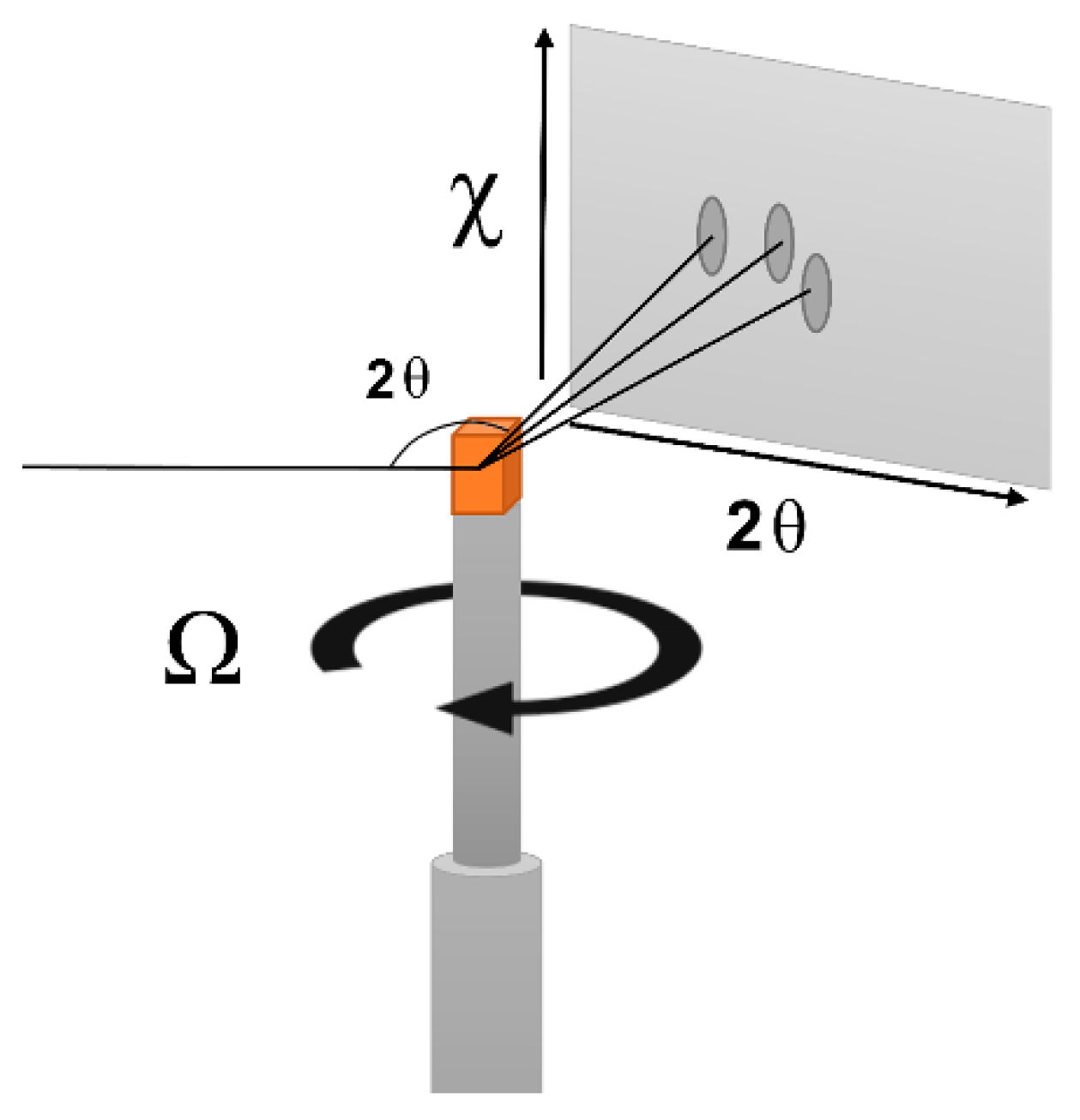
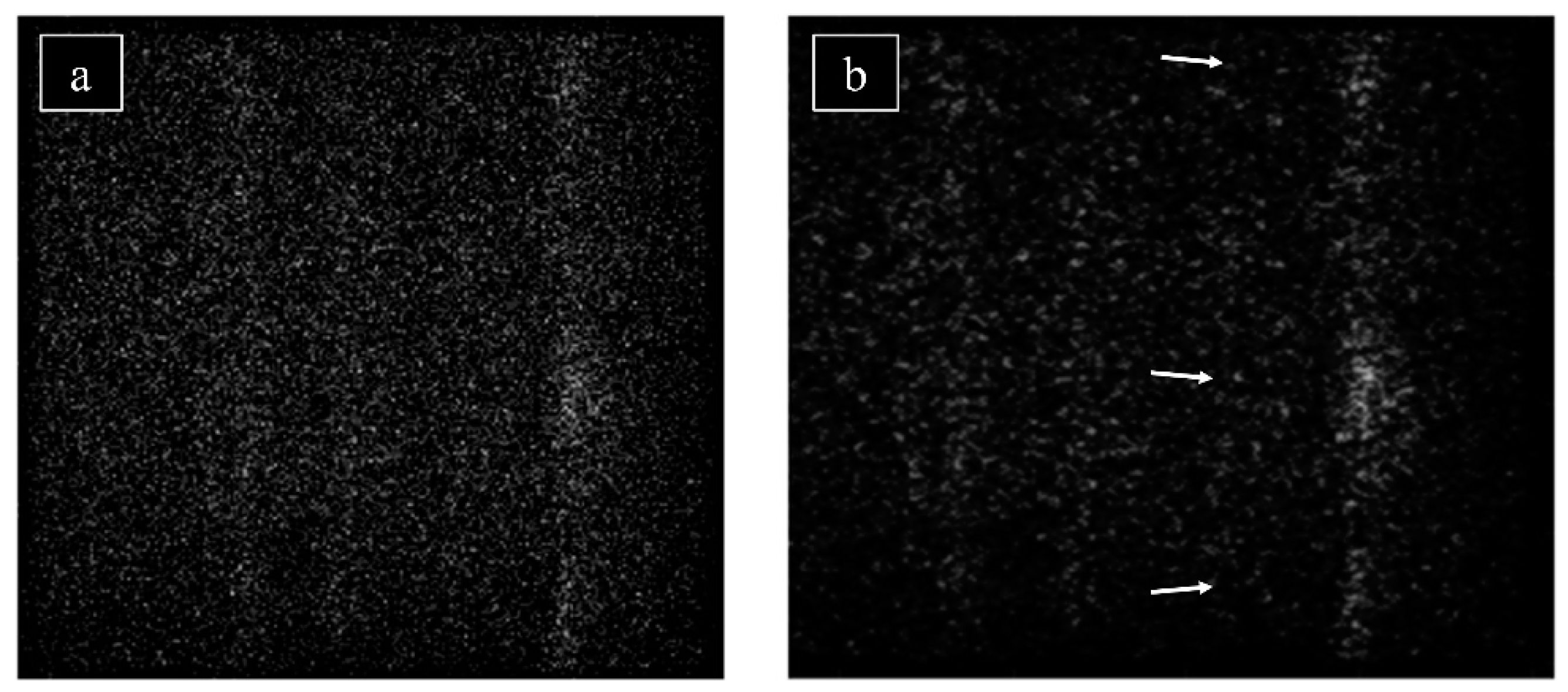
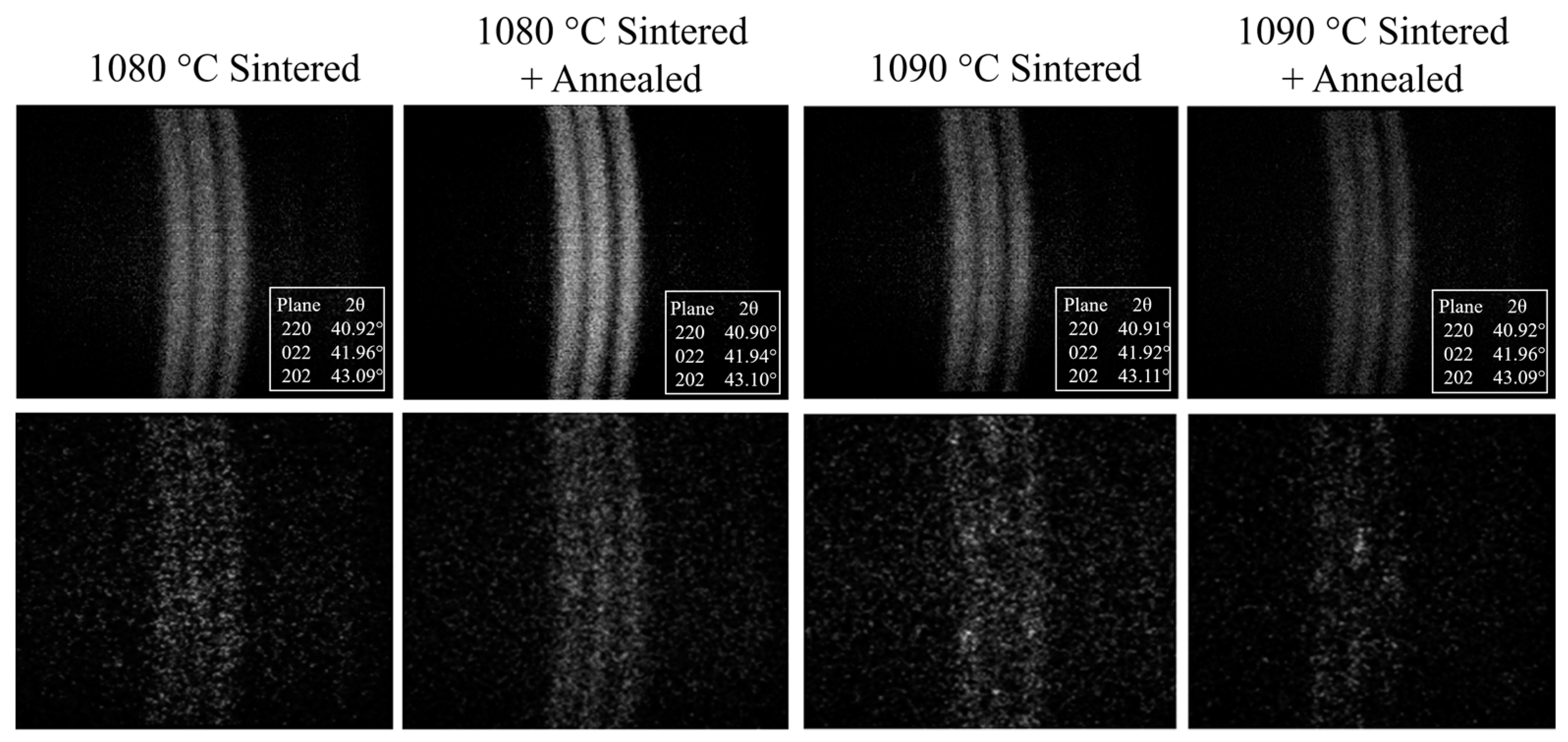
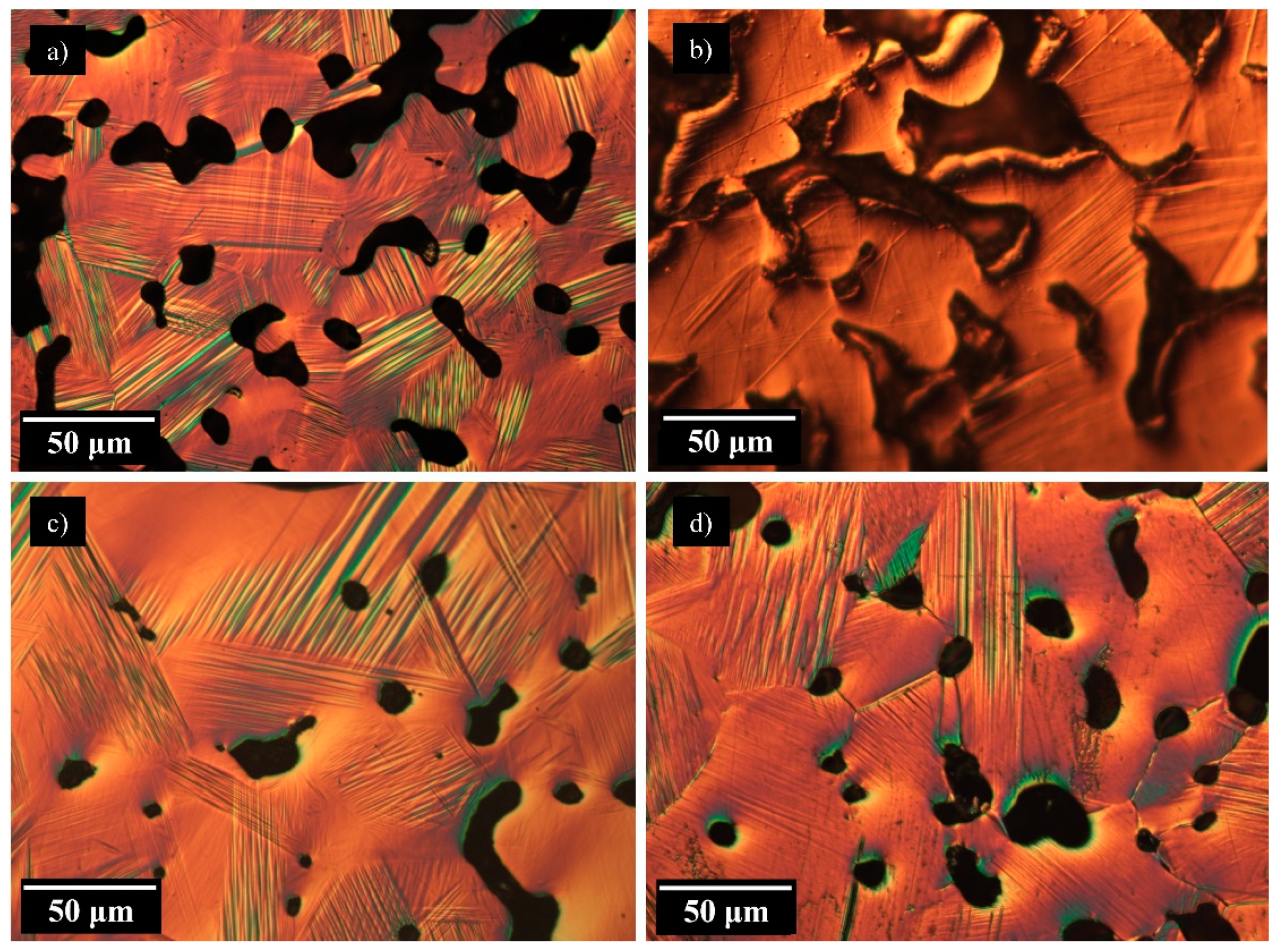



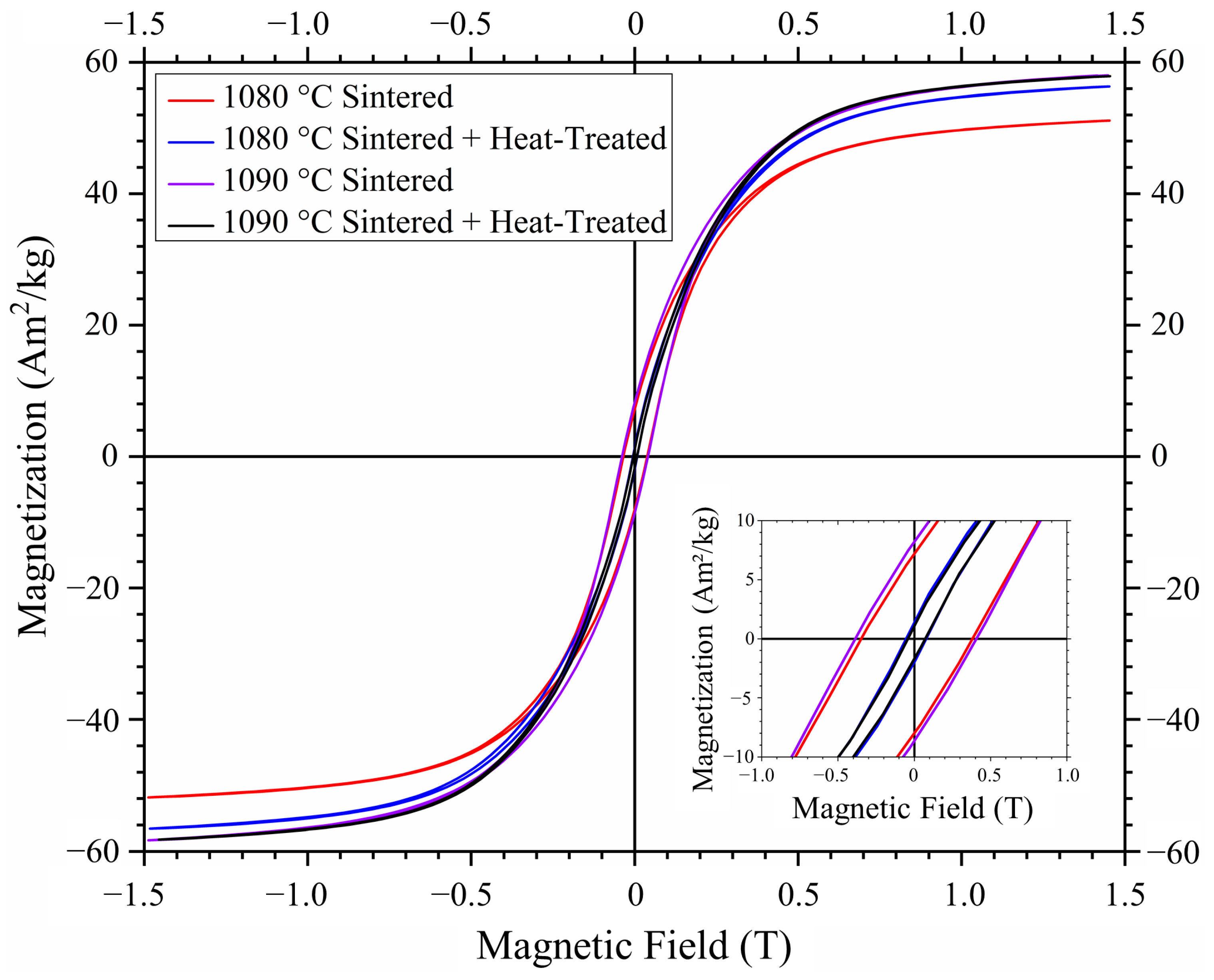
| Parameter | 1080 °C Sintered | 1080 °C Sintered and Annealed | 1090 °C Sintered | 1090 °C Sintered and Annealed |
|---|---|---|---|---|
| a (Å) | 6.169 ± 0.004 | 6.169 ± 0.005 | 6.190 ± 0.005 | 6.177 ± 0.018 |
| b (Å) | 5.822 ± 0.003 | 5.833 ± 0.004 | 5.820 ± 0.003 | 5.823 ± 0.016 |
| c (Å) | 5.531 ± >0.001 | 5.530 ± >0.001 | 5.526 ± 0.001 | 5.530 ± >0.001 |
| c/a | 0.8965 | 0.8958 | 0.8942 | 0.8958 |
| Unit Cell Volume (Å3) | 198.6 ± 0.2 | 198.9 ± 0.3 | 199.0 ± 0.5 | 198.9 ± 1.1 |
| Hardness (GPa) | 3.00 ± 0.24 | 3.36 ± 0.37 | 3.47 ± 0.24 | 3.49 ± 0.22 |
| Reduced Elastic Modulus (GPa) | 92.6 ± 7.3 | 88.3 ± 13.7 | 104.9 ± 12.2 | 108.5 ± 7.0 |
| Relative Density (%) | 79.4 ± 5.6 | 80.1 ± 2.0 | 94.2 ± 2.3 | 94.6 ± 3.5 |
| Foam Elastic Modulus (GPa) | 91.7 ± 7.97 | 87.1 ± 14.7 | 105 ± 13.8 | 109 ± 7.90 |
| Projected Bulk Elastic Modulus (GPa) | 147 ± 11.7 | 136 ± 23.0 | 119 ± 15.6 | 123 ± 8.98 |
| Grain Diameter (μm) | 43.6 ± 1.9 | 48.9 ± 2.9 | 82.4 ± 2.6 | 91.6 ± 2.4 |
| AS (°C) | 84.5 | 82.4 | 75.6 | 80.0 |
| AF (°C) | 91.2 | 91.3 | 82.5 | 89.9 |
| AP (°C) | 89.0 | 89.2 | 79.3 | 86.3 |
| MS (°C) | 86.7 | 87.2 | 77.1 | 82.0 |
| MF (°C) | 78.8 | 75.7 | 68.7 | 70.2 |
| MP (°C) | 83.5 | 83.2 | 72.4 | 77.4 |
| Ttrans (°C) | 86.3 | 86.2 | 75.9 | 81.9 |
| TC (°C) | 88 | 88 | 88 | 87 |
| Msat (Am2/kg) | 52.4 | 56.4 | 58.0 | 57.9 |
Publisher’s Note: MDPI stays neutral with regard to jurisdictional claims in published maps and institutional affiliations. |
© 2022 by the authors. Licensee MDPI, Basel, Switzerland. This article is an open access article distributed under the terms and conditions of the Creative Commons Attribution (CC BY) license (https://creativecommons.org/licenses/by/4.0/).
Share and Cite
Acierno, A.; Mostafaei, A.; Toman, J.; Kimes, K.; Boin, M.; Wimpory, R.C.; Laitinen, V.; Saren, A.; Ullakko, K.; Chmielus, M. Characterizing Changes in Grain Growth, Mechanical Properties, and Transformation Properties in Differently Sintered and Annealed Binder-Jet 3D Printed 14M Ni–Mn–Ga Magnetic Shape Memory Alloys. Metals 2022, 12, 724. https://doi.org/10.3390/met12050724
Acierno A, Mostafaei A, Toman J, Kimes K, Boin M, Wimpory RC, Laitinen V, Saren A, Ullakko K, Chmielus M. Characterizing Changes in Grain Growth, Mechanical Properties, and Transformation Properties in Differently Sintered and Annealed Binder-Jet 3D Printed 14M Ni–Mn–Ga Magnetic Shape Memory Alloys. Metals. 2022; 12(5):724. https://doi.org/10.3390/met12050724
Chicago/Turabian StyleAcierno, Aaron, Amir Mostafaei, Jakub Toman, Katerina Kimes, Mirko Boin, Robert C. Wimpory, Ville Laitinen, Andrey Saren, Kari Ullakko, and Markus Chmielus. 2022. "Characterizing Changes in Grain Growth, Mechanical Properties, and Transformation Properties in Differently Sintered and Annealed Binder-Jet 3D Printed 14M Ni–Mn–Ga Magnetic Shape Memory Alloys" Metals 12, no. 5: 724. https://doi.org/10.3390/met12050724
APA StyleAcierno, A., Mostafaei, A., Toman, J., Kimes, K., Boin, M., Wimpory, R. C., Laitinen, V., Saren, A., Ullakko, K., & Chmielus, M. (2022). Characterizing Changes in Grain Growth, Mechanical Properties, and Transformation Properties in Differently Sintered and Annealed Binder-Jet 3D Printed 14M Ni–Mn–Ga Magnetic Shape Memory Alloys. Metals, 12(5), 724. https://doi.org/10.3390/met12050724








